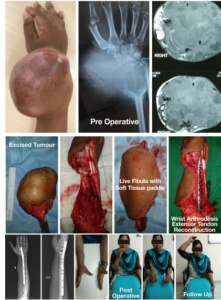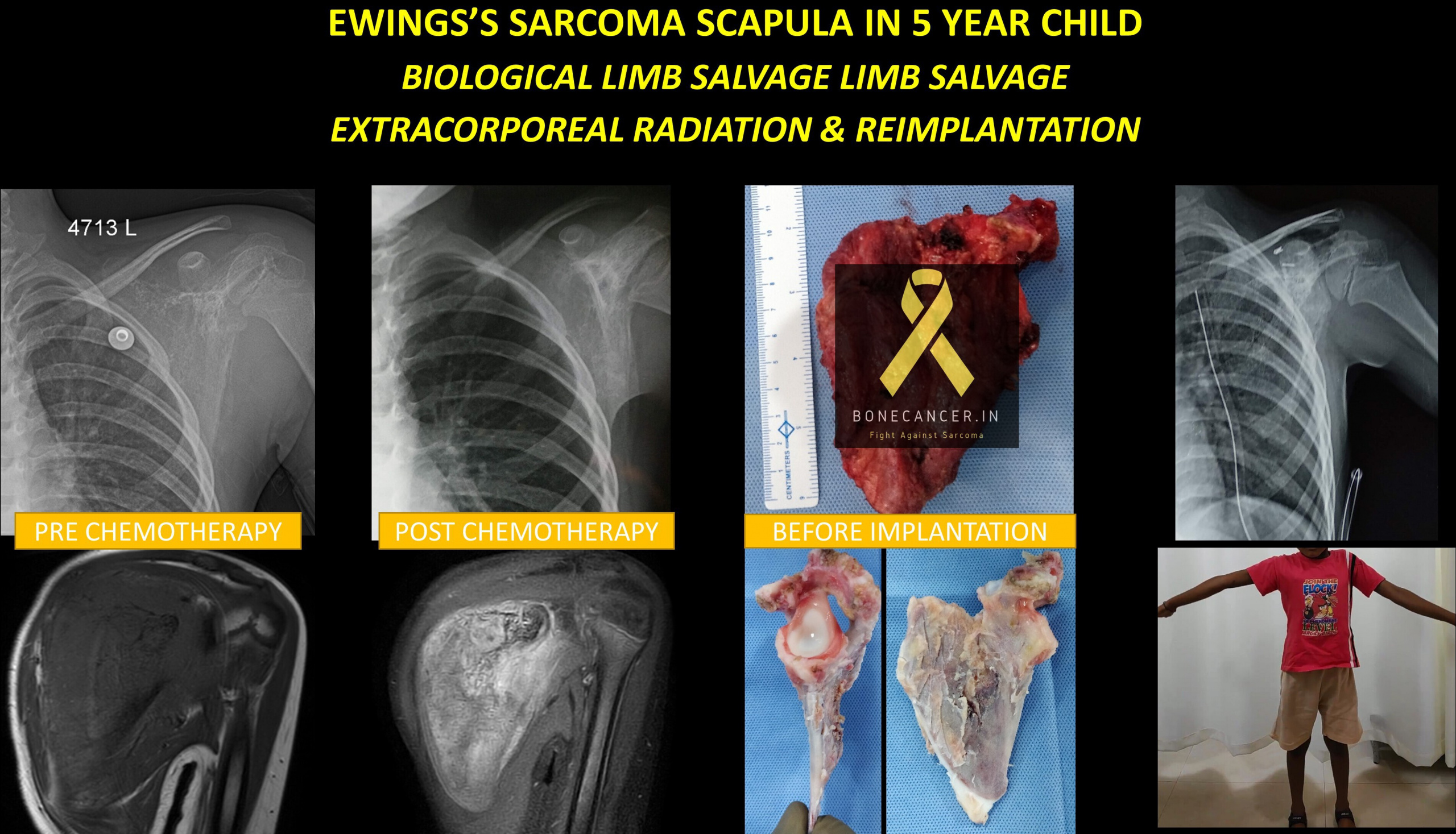Biological Reconstruction
- Biological reconstruction is a process of reconstructing the defect after removal of sarcoma is performed with either host bone or Autograft/Tumor Autograft or Bone Allograft.
- It leads to more biological response and healing and avoids complications associated with Endoprosthesis reconstructions.
- These grafts can be utilized in procedures such as Intercalary reconstruction (which saves the adjacent joints), arthrodesis or in joint reconstructions (Osteoarticular).
What are the different types ?
- Intercalary Reconstruction
- A sarcoma which involves the shaft of long bone and spares the joint can be completely removed and the defect can be reconstructed in biological method or by segmental modular spacer implants.
- Different options of reconstruction are as follows:
- Bone graft
- Cement Spacer with Nail &/Or Plate, screws
- Tumour Endoprosthesis
- Arthrodesis
- Bridging the defect above and below the joint by combination of graft and metal implants results in a stiff but stable limb.
- The motion at the native joint is lost in arthrodesis.
- In case of lower limb, the affected limb will be shortened by 2-3 cms to aid walking.
- This option is provided when the individual requires to perform high demand, heavy labor or manual work at the expense of joint mobility.
- Currently, Arthrodesis is preferred for upper limb, and rarely for lower limb
What are the various biological reconstruction options ?
- Autograft
-
- Vascularised Bone Graft (Fibula, Rib)
- Non Vascularised Bone Graft (Fibula, Rib)
- Fibula Autograft is a very useful and expendable bone in the leg.
- Adequate lengths of fibula are harvested from the patient’s same or opposite leg to help in reconstruction.
- For defects ≤ 10 cms fibula is harvested and placed in defect alone or in combination with allograft.
- For defects ≥ 10 cms, the fibula is harvested usually from the opposite leg with periosteum and blood vessels supply intact (Vascularized Fibula).
- This is then anastomosed in the recipient area with a host blood vessel and used alone or in combination with massive bone allograft.
- Advantages of vascularized fibula are easy transport to any defect in the body, biological reconstruction, less risk of graft failure complications due to intact blood supply and potential for overgrowth of the fibula in reconstructions.
-

- Allograft
-
- Massive Bone Allograft
- Osteoarticular allograft
- Cancellous or Morselized Bone Allograft
- After the tumor resection, the Massive bone allograft that has been carefully size-matched to the intended recipient is cut to the appropriate shape.
- The shaft of the allograft is fixed to the end of the host bone with a bone plate or an intramedullary rod with screws.
-
-
- For Osteoarticular allograft reconstructions of a joint, a massive bone allograft with intact joint capsule and ligaments that matches the articular size and geometry of the resected specimen as closely as possible is selected.
- The capsule and ligaments of the allograft are attached to their counterparts on the host bone. Muscle insertions are repaired to the stumps of tendons on the allograft. This procedure prevents usage of metal in the joint.
- Major disadvantage is the degeneration of the joint surface over a short period of time requiring Endoprosthesis reconstruction.
- There is a theoretical risk of transmission of viral infections such as HIV, Hepatitis B & C which is negligible since the allograft is stored in the freezer at minus 80 degree Celsius and radiated which kills the virus.
- https://bonecancer.in/2020/04/29/what-is-allograft-prosthetic-composite-reconstruction-apc/
- Recycled Tumour Graft
- Irradiated Tumour Autograft (ECRT)
- Cryotherapy (Liquid Nitrogen)
- Pedicle Cryotherapy
- Free Cryotherapy
- Tumor Autograft (ECRT) is performed when the host bone involved with sarcoma has adequate structural integrity and strength maintained (i.e. the tumor has involved the bone but not weakened it completely to replace it with other methods).
- The removed host bone is stripped of any soft tissue attachment and subjected to 50 Cgy of radiation in a sterile environment.
- The medullary canal is cleared and the ECRT graft is washed and placed in antibiotic solution prior to reimplantation with help of plate and screws.
- The advantage in this procedure is the host bone is reinserted and does not need the careful planning required in massive bone allografts and associated complications.
-
- In Cryotherapy, the tumour bone is dipped in Liquid Nitrogen for 15 minutes (Pedicled is where tumour segment is attached to body, whereas Free is tumour segment is removed from both ends of body).
- This frozen bone is allowed to thaw in room air for 20 minutes followed by dipping in distilled water for 15 minutes. The cryotherapy treated bone is then implanted to host defect with appropriate reconstruction techniques.
- The risk of local recurrence in recycling of bone is less than 1 -2 %.
What are the complications associated with biological reconstruction?
- Common complications of any graft usage are:
- Delayed union, mal-union, non-union
- Graft fracture
- Infection
- Implant breakage
- Graft resorption
- Adjuvant treatment with chemotherapy and radiation may also increase the complication rate.
It is rare to find graft rejection since the allograft or recycled tumor graft has lost all its reactive immune properties.
External Links:
https://www.ncbi.nlm.nih.gov/pmc/articles/PMC5384922/
For More Information CONTACT US


1 Comment